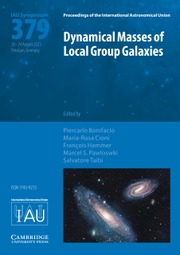No CrossRef data available.
Article contents
Hyperfine structure radio lines from hot ISM in elliptical galaxies
Published online by Cambridge University Press: 21 October 2010
Abstract
Core share and HTML view are not available for this content. However, as you have access to this content, a full PDF is available via the ‘Save PDF’ action button.
Hyperfine structure (HFS) line of 14N VII ion with rest frequency of ν = 53.04 GHz should be detectable from the interstellar medium in some of the densest and coolest cores of elliptical galaxies at redshifts exceeding 0.15 or so.
Information
- Type
- Contributed Papers
- Information
- Proceedings of the International Astronomical Union , Volume 5 , Highlights H15: Highlights of Astronomy , November 2009 , pp. 278
- Copyright
- Copyright © International Astronomical Union 2010
References
Docenko, D. & Sunyaev, R. A. 2007a, in: Böhringer, H., Pratt, G. W., Finoguenov, A., & Schuecker, P. (eds.), Heating versus Cooling in Galaxies and Clusters of Galaxies, ESO Astrophysics Symposia (Berlin, Heidelberg: Springer), p. 333CrossRefGoogle Scholar
Docenko, D. & Sunyaev, R. A. 2007b, in: From Planets to Dark Energy: the Modern Radio Universe, Published online at SISSA, Proceedings of Science, p.90Google Scholar

